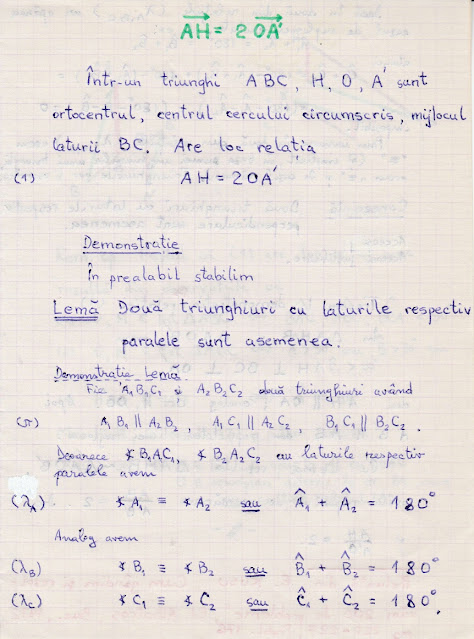(filipineza)
The name "EULER's Lemma" is given by me. This property of the circumcenter and the orthocenter is used in the demonstration of the "
Circle of the Nine Points Theorem".
"
We denote by O, G and H respectively the center of the of a triangle ABC.
Let A' be the midpoint of side [BC]. We have equality
$$AH=2\cdot OA'. " \tag {e}$$
Rem CiP
In reality we have more, the relationship between vectors takes place
$$\overrightarrow{AH}=2 \cdot \overrightarrow{OA'}. \tag {E}$$
CiP Proof (following the text from the images at the beginning)
First we demonstrate
Lemma 1 Two triangles with respectively parallel sides are similar.
Proof of Lemma_1
Let $A_1B_1C_1$ and $A_2B_2C_2$ be two triangles having
$$A_1B_1 \parallel A_2B_2\;,\;\;A_1C_1 \parallel A_2C_2\;,\;\;B_1C_1 \parallel B_2C_2\;. \tag{$\pi$}$$
Since [the angles] $\angle B_1A_1C_1,\;\angle B_2A_2C_2$ have respectively parallel sides, we have
$$\angle A_1 \equiv \angle A_2\;\;\;or \;\;\;\measuredangle A_1+\measuredangle A_2=180^{\circ} \tag {$\lambda_A$}$$
Analogously we have
$$\angle B_1 \equiv \angle B _2\;\;\;or \;\;\; \measuredangle B_1+\measuredangle B_2=180^{\circ} \tag{$\lambda_B$};$$
$$\angle C_1 \equiv \angle C_2\;\;\;or \;\;\; \measuredangle C_1+\measuredangle C_2=180^{\circ} . \tag{$\lambda_C$}$$
If in two of the relations $(\lambda_{A,B,C}$ the case of supplementarity would appear, e.g.
$$\measuredangle A_1+\measuredangle A_2=180^{\circ}=\measuredangle B_1+\measuredangle B_2$$
then
$\measuredangle C_1+\measuredangle C_2=180^{\circ}-(\measuredangle A_1+\measuredangle B_1)+180^{\circ}-(\measuredangle A_2+\measuredangle B_2)=(180^{\circ}-\measuredangle A_1-\measuredangle A_2)+(180^{\circ}-\measuredangle B_1-\measuredangle B_2)=0$
impossible.
Therefore, in two of the relations $(\lambda_{A,B,C})$ we have $"\equiv "$ (and implicitly, based on the sum of the angles of a triangle we have $"\equiv "$ in the remaining case as well). The triangles will be similar.
$\square $<end Proof of L_1>
Lemma 2 Two triangles with respective perpendicular sides are similar.
Same justification.
In [the triangles] $\Delta AHB$ and $\Delta A'OB'$ we have
$$AH \perp BC \perp OA'$$
so $AH \parallel AB$; analogous $BH \parallel OB'$. Then $A'B' \parallel AB$ from the
middle theorem.
With the Lemma 1 result $\Delta AHB \sim \Delta A'OB'$, having the similarity ratio $\frac{AB}{A'B'}=2.$ So also $\frac{AH}{A'O}=2.$
Remark CiP The fact that (e) also occurs as vectors (i.e. (E)) results from the observations:
($\alpha$) $O,\;H\;\in Int \Delta ABC\;\;\Leftrightarrow\;\widehat{BAC},\;\widehat{ABC},\;\widehat {BCA}\;<90^{\circ}$
($\beta$) $O,\;H\;\in Ext \Delta ABC\;\;\Leftrightarrow\;\widehat{A}\;>90^{\circ}\;or\;\widehat{B}\;>90^{\circ}\;or\; \widehat{C}\;>90^{\circ}$
($\gamma$) $H=A,\;O=A'\;\;\Leftrightarrow\;\widehat{A}=90^{\circ}.$
Moreover, in the case $(\beta)$ we can specify:
$\widehat{BAC}>90^{\circ}\;\Rightarrow\;H\in Int \{opposite\;angle\;at\;the\;apex\;with\; \angle BAC\}$
and $O\in \{the\;half-plane\;determined\;by\;the\; line\;BC,\;which\;does\;\underline{not}\;contain\;the\;vertex\;A \}$
$\blacksquare \blacksquare$











